.jpeg)
GS500 OBD/EOBD,code scanner
| Min. Order: | 1 Set/Sets |
|---|---|
| Payment Terms: | western union, T/T, paypal/moneybooker |
| Supply Ability: | 300 sets per week |
| Place of Origin: | Guangdong |
Company Profile
| Location: | Shenzhen, Guangdong, China (Mainland) |
|---|---|
| Business Type: | Manufacturer, Trading Company |
Product Detail
| code scanner: | gs500 |
|---|---|
| gs500: | OBDII |
| Production Capacity: | 300 sets per week |
| Packing: | retail / shipping package |
| Delivery Date: | within 3 days after payment |
Product Description
GS500 OBD II Code Scanner
The OBD-GS500 includes many professional features in an inexpensive scan tool. The scan tool delivers all nine OBDII test modes, retrieving live engine datastream and parameters to enable technicians to accurately diagnose the toughest problems. II).
Features & Benefits
Reads & clears generic OBD II trouble codes (including pending codes)
Turns off check engine light(MIL)
Displays Generic Codes P0, P2, P3, U0 and Manufacturer Specific Codes P1, P3, and U1
Displays OBD2 monitor and I/M readiness Status
Detects OBD-II Freeze Frame Information
Reads live PCM data stream
Displays live O2 sensor test data
Performs Modules Present Test
Supports CAN(Controller Area Network) and all other current OBD-II protocols
Built-in OBD-II DTC lookup library
State Emissions Check(OBD2)
Retrieves Vehicle information (VIN, CID and CVN)
Determines the malfunction indicator lamp (MIL) status
Code definitions displayed on unit screen
Unit updateable via Internet
Highly reliable and accurate
Easy-to-read crystal-clear backlit large 128 x 64 LCD display(2.8 x 1.7)
Safely communicates with the on-board computer
Features & Benefits
Reads & clears generic OBD II trouble codes (including pending codes)
Turns off check engine light(MIL)
Displays Generic Codes P0, P2, P3, U0 and Manufacturer Specific Codes P1, P3, and U1
Displays OBD2 monitor and I/M readiness Status
Detects OBD-II Freeze Frame Information
Reads live PCM data stream
Displays live O2 sensor test data
Performs Modules Present Test
Supports CAN(Controller Area Network) and all other current OBD-II protocols
Built-in OBD-II DTC lookup library
State Emissions Check(OBD2)
Retrieves Vehicle information (VIN, CID and CVN)
Determines the malfunction indicator lamp (MIL) status
Code definitions displayed on unit screen
Unit updateable via Internet
Highly reliable and accurate
Easy-to-read crystal-clear backlit large 128 x 64 LCD display(2.8 x 1.7)
Safely communicates with the on-board computer
Communication Protocols Included
C.A.N. (Controller Area Network)
J1850PWM
J1850VPW
KWP 2000 ISO 14230-4
ISO 9141
C.A.N. (Controller Area Network)
J1850PWM
J1850VPW
KWP 2000 ISO 14230-4
ISO 9141
Contents Included
OBD-GS500 unit
OBD2 Cable
USB update Cable
Users Manual & DTC Library software CD
One Soft Nylon Carry Case
OBD-GS500 unit
OBD2 Cable
USB update Cable
Users Manual & DTC Library software CD
One Soft Nylon Carry Case
Will This Code Reader Work with My Car
The Geniscan OBD II Code Reader is specially designed to work with all OBD II compliant vehicles. It is required by EPA that All 1996 and newer vehicles (cars and light trucks) sold in the United States must be OBD II compliant and this includes all Domestic, Asian and European vehicles.
A small number of 1994 and 1995 model year gasoline vehicles are OBD II compliant. To verify if a 1994 or 1995 vehicle is OBD II compliant, check the Vehicle Emissions Control Information (VECI) Label which is located under the hood or by the radiator of most vehicles. If the vehicle is OBD II compliant, the label will designate OBD II Certified. Additionally, Government regulations mandate that all OBD II compliant vehicles must have a common sixteen-pin Data Link Connector (DLC).
For your vehicle to be OBD II compliant, it must have a 16 pin DLC (Data Link Connector) under the dash and the Vehicle Emission Control Information Label must state that the vehicle is OBD II compliant. This label is located on the inside of the hood on most vehicles.



.jpg)
.jpg)


